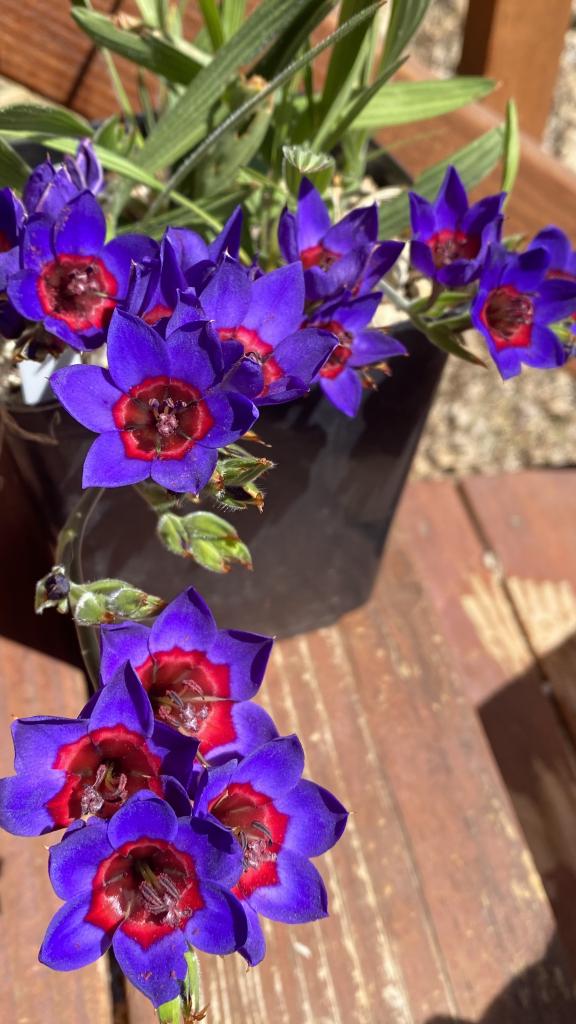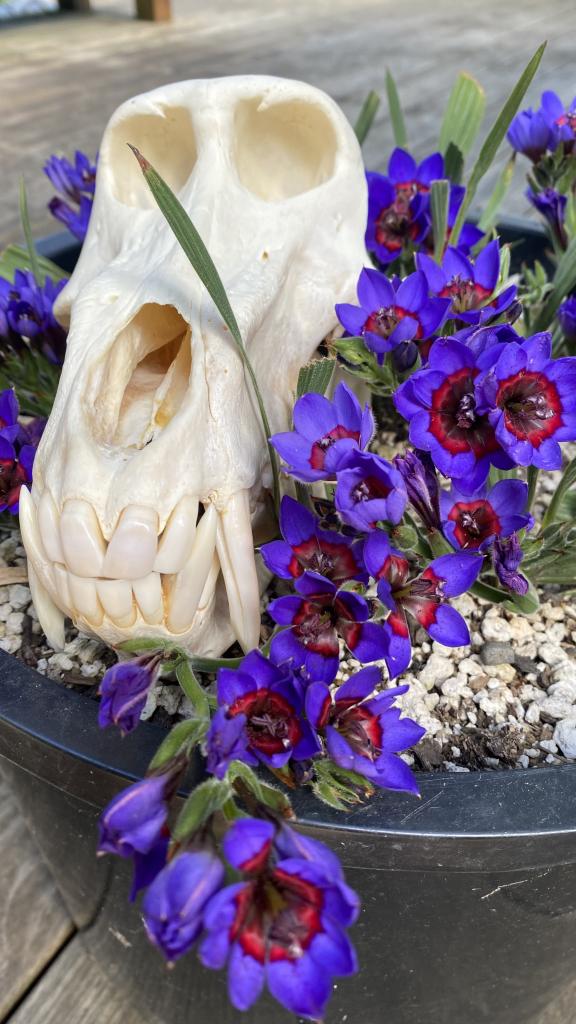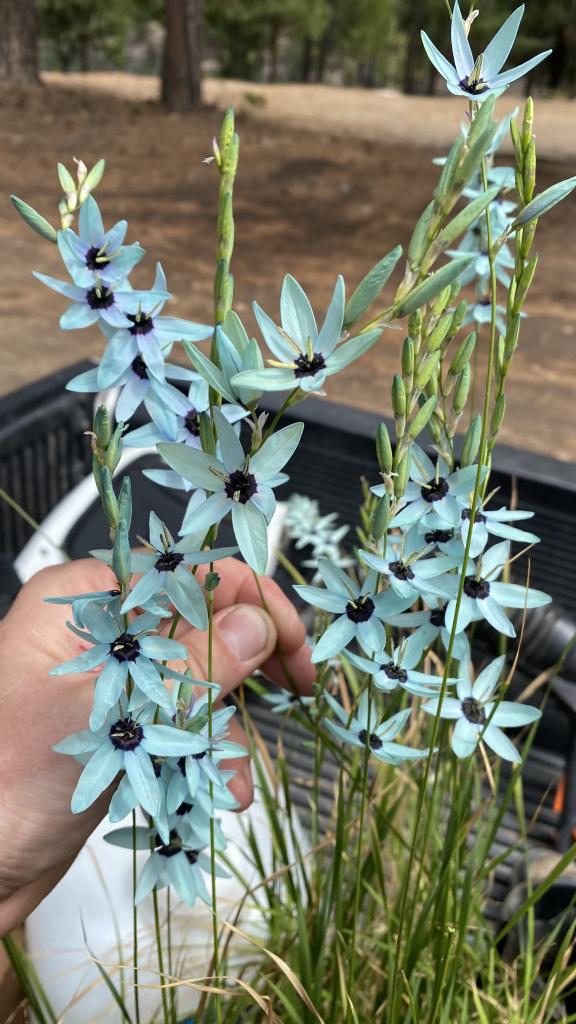Here is a picture of the only gnarled flower from this year. Only this one flower on the inflorescence though. Last year growing these outside in the heat there were more like this, plus many flowers had barren anthers, no pollen produced at all. Only grew for about two months, fully dormant with leaves withered by middle/end of July. Could this be a symptom of virus, being expressed under stressful and harsh conditions? Years ago when I grew Bessera I never had any issues.
- Welcome to PBS Forum.
This section allows you to view all posts made by this member. Note that you can only see posts made in areas you currently have access to.
Pages1
#2
General Discussion / Re: Bessera - Setting Seed
July 21, 2022, 10:17:36 PM
Very interesting. Diana Chapman said she knows of people in the central valley of California that don't have luck with the species due to the heat, but being in humid PA with days in the 90's and nights that likely don't cool off a ton, that says differently for sure.
Did you acquire your bulbs from Telos? I was wondering if since Diana raised the bulbs I got from her in a cooler climate, these may have adapted to cooler conditions and thus don't respond well to heat. Its odd how if left outside my plants were fully dormant by mid July, whereas for other people they don't go dormant until fall. Not sure what it is.
Did you acquire your bulbs from Telos? I was wondering if since Diana raised the bulbs I got from her in a cooler climate, these may have adapted to cooler conditions and thus don't respond well to heat. Its odd how if left outside my plants were fully dormant by mid July, whereas for other people they don't go dormant until fall. Not sure what it is.
#3
General Discussion / Bessera - Setting Seed
July 21, 2022, 03:51:27 PM
Growing now in a warm climate (souther Oregon - average highs 95F day, 55F night), im having issues with Bessera elegans (may now be elegantissima) setting seed. Should note this is the purple form of Bessera. Last year when left outside, the flowers were gnarled and many lacked pollen and dormancy was pretty much complete by end of July. All attempted seed pods were aborted.
This year growing inside under lights with temperatures around 75-80F day and 65-70F night, flowers seem normal at large, pollen production seems normal, but seed pods appear to be dropping again as well. When I grew this species coastally, I never had issues setting seed. Anyone have experience of what Bessera prefers for flowering and seed setting?
Thanks!
Colin
Southern Oregon
Zone 8b
This year growing inside under lights with temperatures around 75-80F day and 65-70F night, flowers seem normal at large, pollen production seems normal, but seed pods appear to be dropping again as well. When I grew this species coastally, I never had issues setting seed. Anyone have experience of what Bessera prefers for flowering and seed setting?
Thanks!
Colin
Southern Oregon
Zone 8b
#4
General Discussion / Re: Bessera
July 21, 2022, 03:46:04 PM
Thats awesome, I totally missed that paper and update. Thanks for sharing!
#5
Current Photographs / Re: Lachenalia aloides v. vanzyliae hybrids
April 26, 2022, 02:51:00 AM
Ottoline - picture 5604 is one of my hybrids I call 'Aurora'. It definitely shows hybrid vigor.
Lee - Yes I recall the Komoriya hybrids, although at the time I was really only focused on species, so never got too excited. But yes, some didn't seem all that interesting. Kind of glad I dont recall the prettier ones now lol, I spend too much on plants as it is! By the way the Leucocoryne vittata I got from you years back is still going strong, absolutely love that form, thanks again!
Colin
Lee - Yes I recall the Komoriya hybrids, although at the time I was really only focused on species, so never got too excited. But yes, some didn't seem all that interesting. Kind of glad I dont recall the prettier ones now lol, I spend too much on plants as it is! By the way the Leucocoryne vittata I got from you years back is still going strong, absolutely love that form, thanks again!
Colin
#6
Current Photographs / Re: Lachenalia aloides v. vanzyliae hybrids
April 24, 2022, 07:54:08 PM
Lachenalia 'Twilight' - Lachenalia aloides v. vanzyliae 'Galaxy' x Lachenalia aloides v. aurea (dark orange form with purple scapes). This hybrid exhibits some of the purple/blue on the upper scape and lower sepals from the 'Galaxy' parent.
#7
Current Photographs / Re: Lachenalia aloides v. vanzyliae hybrids
April 24, 2022, 07:47:36 PM
Lachenalia 'Aurora' - Lachenalia aloides v. vanzyliae 'Davis HSC' x Lachenalia callista. Beautiful pastel colors that develop leading up to Easter, very vigorous strong growth.
#8
Current Photographs / Lachenalia aloides v. vanzyliae hybrids
April 24, 2022, 07:41:17 PM
Lachenalia's have long been my passion - L. viridiflora being the first species that ignited a passion for SA bulbs. Turquoise is the rarest of all colors in the plant world, so naturally I was drawn to it. Being that the aloides clan has a great amount of diversity and largely bloom at the same time, they are ripe candidates for creating hybrids. In the following posts are two very stunning hybrids (in my opinion) worth mentioning, with vanzyliae as the parent. I have several clones of vanzyliae, the two below being the best. The one on the right is 'Davis HSC' - a darker, more saturated variant from UC Davis with strongly mottled foliage. The one on the left is what I call Lachenalia vanzyliae 'Galaxy', a rare variety from an famous botanic garden. This clone displays excellent coloration reminiscent of a galaxy: turquoise, green and violet/purple. Also shows strong mottling, with a beautiful purple shade to the leaves.
Colin
Colin
#9
Current Photographs / Babiana rubrocyanea
April 24, 2022, 06:42:17 PM
Blooming now is Babiana rubrocyanea, or Baboon Flower (probably the only species I grow that I actually know the common name lol). I don't feel this species receives enough attention - its easy, reliable and has stunning saturation. If you don't grow it, you should!
Colin
(and yes, real Baboon skull - even in death they plague the Babiana!)

Colin
(and yes, real Baboon skull - even in death they plague the Babiana!)
#10
Current Photographs / Re: Ixia viridiflora
April 24, 2022, 06:34:27 PM
Uli,
Thats a great question, and even after 15 years i'm still on the fence. By the time September rolls around i'm itching to get fall bulbs started, but I try to wait until days are no longer in the 80's, which is usually very end of September here. Lots of winter growing bulbs naturally begin growth as temperatures begin to drop in August/September - the earliest being Oxalis and Lachenalia (for putting out root initials). In my opinion temperature is the biggest factor for signaling bulb growth, with moisture being the second.
To clarify about fall watering - the first watering in of bulbs is a very deep, thorough watering. If your soil is peat based, as many are, a summer with no water has made it very hydrophobic, so over the course of a day or two I give many repeated drenchings to try to get the entire soil column as saturated as possible. Once I feel the pots are sufficiently re-wetted, then I do not water at all until I begin to see leaves/shoots pushing through the surface. This is general advice too, not just for Ixia. Once there is visible growth on the surface, then I begin watering at regular intervals.
It's true that water + heat can be a lethal combination for these bulbs, which is why I generally stay away from all summer water. It MAY be beneficial, but without exact knowledge of your soil, container, container size, humidity and temperature it's risky business giving supplemental summer water. Last summer I had accidentally stacked my dormant 7 gallon pots of Ixia viridiflora directly on top of each other, and digging around in July showed that the pot on the bottom had retained far too much moisture and bulbs were indeed rotting. The pot on the top had dried as it should and all bulbs were in perfect condition.
Without knowing specifics I would recommend watering your plants starting in September, but I really feel that daytime temperatures need to be around 75F or lower, thats your best bet in terms of avoiding rot. Whether for you thats early September or closer to October, go off of that. Thats a conservative approach I know, but with the amount of bulbs I have I don't like to take chances.
Colin
Thats a great question, and even after 15 years i'm still on the fence. By the time September rolls around i'm itching to get fall bulbs started, but I try to wait until days are no longer in the 80's, which is usually very end of September here. Lots of winter growing bulbs naturally begin growth as temperatures begin to drop in August/September - the earliest being Oxalis and Lachenalia (for putting out root initials). In my opinion temperature is the biggest factor for signaling bulb growth, with moisture being the second.
To clarify about fall watering - the first watering in of bulbs is a very deep, thorough watering. If your soil is peat based, as many are, a summer with no water has made it very hydrophobic, so over the course of a day or two I give many repeated drenchings to try to get the entire soil column as saturated as possible. Once I feel the pots are sufficiently re-wetted, then I do not water at all until I begin to see leaves/shoots pushing through the surface. This is general advice too, not just for Ixia. Once there is visible growth on the surface, then I begin watering at regular intervals.
It's true that water + heat can be a lethal combination for these bulbs, which is why I generally stay away from all summer water. It MAY be beneficial, but without exact knowledge of your soil, container, container size, humidity and temperature it's risky business giving supplemental summer water. Last summer I had accidentally stacked my dormant 7 gallon pots of Ixia viridiflora directly on top of each other, and digging around in July showed that the pot on the bottom had retained far too much moisture and bulbs were indeed rotting. The pot on the top had dried as it should and all bulbs were in perfect condition.
Without knowing specifics I would recommend watering your plants starting in September, but I really feel that daytime temperatures need to be around 75F or lower, thats your best bet in terms of avoiding rot. Whether for you thats early September or closer to October, go off of that. Thats a conservative approach I know, but with the amount of bulbs I have I don't like to take chances.
Colin
#11
Current Photographs / Re: Ixia viridiflora
April 24, 2022, 05:18:40 AM
I've found Ixia viridiflora to be quite easy and not at all short lived, given that it receives proper care. Having lived in both truly coastal and inland climates, I have experience with this species in areas that rarely exceed 75 degrees in summer, and areas that routinely get up into the low 100's/high 90's. I forgot I had posted about growing this species before, but re-reading that 3 years later I agree even more. Summer water has not proven helpful for me, and may even be detrimental. The only mature bulbs I have lost have remained too damp for too long into dormancy. Those that have had a completely dry and hot dormancy rarely perish, and have lived for years and years regularly producing offsets and flowering. That said, my best performance has been in large 7 gallon plastic pots that have a longer and slower drying off period once water is withheld in late May/June (Southern Oregon), but then I've seen great performance in smaller containers as well. By the time growth resumes in September/October the soil is bone dry, and I have excellent performance doing this. If you were growing in terra cotta pots you might consider watering once or twice in summer, but I really do not think this is necessary.
The single biggest factor for bulbs re-emerging in fall and flowering in spring is a hot dormancy period (or at least warmer). Ixia, as well as many other South Africans, really struggle to re-emerge without that summer heat during dormancy. In short - this species wants sharply draining soil, full sun, lots of water during growth and a hot, dry summer dormancy. Mary Sue has previously discussed the difficulty of growing some other bulbs in her coastal climate, such as Lapeirousia oreogena - which literally shows up as a weed in pots here. Biggest difference is I get a very hot and dry dormancy period. I don't think the importance of summer heat can be exaggerated. Even if for you that means moving dormant pots to a warmer attic in summer, it will help.
Ixia viridiflora
-Soil - Typical bulb mix (although this species can take higher amounts of organic matter than others) of equal parts pumice, sand and potting soil (I use Fox Farms Happy Frog)
-Water - Ample water fall through spring (usually water once deeply as temperatures start to drop in late September, then resume regular watering once I see growth emerge, continuing through late May/June once foliage begins to wither/seed is collected)
-Light - Full sun (part shade in early fall and late spring in hot climates, but still full sun in winter)
-Planting Depth - Around 3"
-Temperature (current location)- average 45-60 daytime in winter, nighttime lows in the low-mid 30's-40's. Has proven hardy to down to 16F for short and irregular periods (with frost blanket). I wouldn't want to try growing this unprotected outdoors in colder climates than 8b, I think i'm on the lower end cusp.
-Dormancy - June through September. In hot climates move pots into shade (full sun will cook bulbs), but don't stack pots as that can retain too much moisture for too long. In cooler climates that don't exceed 85F in summer, move bulbs to an attic or as warm a location as possible.
Colin
The single biggest factor for bulbs re-emerging in fall and flowering in spring is a hot dormancy period (or at least warmer). Ixia, as well as many other South Africans, really struggle to re-emerge without that summer heat during dormancy. In short - this species wants sharply draining soil, full sun, lots of water during growth and a hot, dry summer dormancy. Mary Sue has previously discussed the difficulty of growing some other bulbs in her coastal climate, such as Lapeirousia oreogena - which literally shows up as a weed in pots here. Biggest difference is I get a very hot and dry dormancy period. I don't think the importance of summer heat can be exaggerated. Even if for you that means moving dormant pots to a warmer attic in summer, it will help.
Ixia viridiflora
-Soil - Typical bulb mix (although this species can take higher amounts of organic matter than others) of equal parts pumice, sand and potting soil (I use Fox Farms Happy Frog)
-Water - Ample water fall through spring (usually water once deeply as temperatures start to drop in late September, then resume regular watering once I see growth emerge, continuing through late May/June once foliage begins to wither/seed is collected)
-Light - Full sun (part shade in early fall and late spring in hot climates, but still full sun in winter)
-Planting Depth - Around 3"
-Temperature (current location)- average 45-60 daytime in winter, nighttime lows in the low-mid 30's-40's. Has proven hardy to down to 16F for short and irregular periods (with frost blanket). I wouldn't want to try growing this unprotected outdoors in colder climates than 8b, I think i'm on the lower end cusp.
-Dormancy - June through September. In hot climates move pots into shade (full sun will cook bulbs), but don't stack pots as that can retain too much moisture for too long. In cooler climates that don't exceed 85F in summer, move bulbs to an attic or as warm a location as possible.
Colin
Pages1
